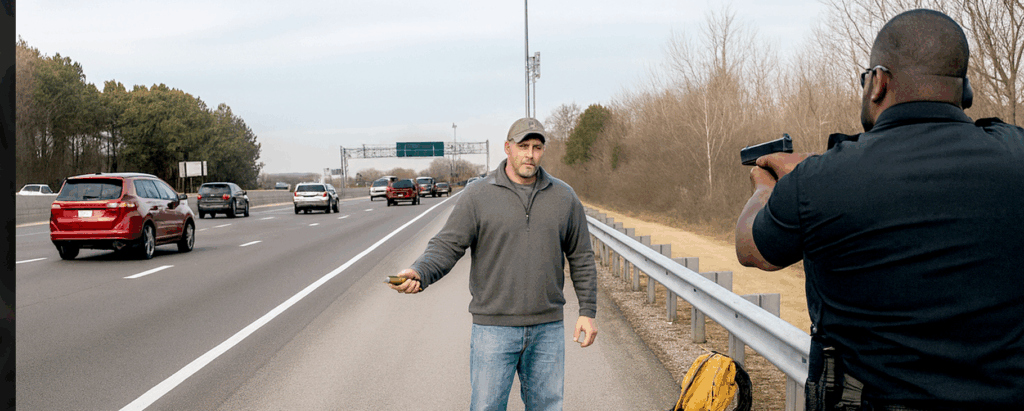Lewis, et al. v. City of Edmond, et al., 2022 WL 4282659 (10th Cir. 2022)
Isaiah Mark Lewis was at his girlfriend’s house one morning when she noticed he was acting strangely. They got into a fight when Lewis asked to look at her cell phone. A neighbor called 911 and stated a young man was “beating up” a girl. When officers arrived, Lewis’ girlfriend said reports of a physical altercation between the two were overblown.
In the meantime, Lewis stripped naked and fled on foot. Police searched for him for approximately an hour. Sergeant Box and Officer Scherman spotted Lewis in a yard in a nearby neighborhood. Sergeant Box confronted Lewis and identified himself as a police officer, pointed his TASER device at Lewis, and commanded him to stop and get on the ground. Lewis turned to a nearby house and “busted through the front door’s oval glass window” to get inside. The officers did not believe it was Lewis’s home and did not know whether anyone other than Lewis was inside.
Taser Deployment Fails to Subdue Suspect
Sergeant Box followed Lewis inside and, seeing him attempt to leave through the back door, again told Lewis to stop and get on the ground. Lewis then turned and charged at Sergeant Box. Sergeant Box fired the TASER device, which had no effect on Lewis. While they fought in the living room, Sergeant Box fired the TASER device a second time, again without effect. Officer Scherman came into the living room where he saw “Lewis pummeling Box…Lewis continued to strike Box in the head, face, and neck, and Box attempted to use his taser [a third time] to drive stun Lewis.”
Sergeant Box disappeared from Officer Scherman’s line of sight as Lewis turned toward Officer Scherman (who the court described as an “undersized officer”). Officer Scherman drew his firearm and shot Lewis four times as Lewis advanced toward him. Lewis died from the gunshot wounds.
Conflicting Accounts of the Deadly Encounter
The trial court stated: “Plaintiffs do not dispute that after his fight with Box in the living room, Lewis turned toward Scherman and advanced in his direction as Scherman backed down the entry hallway toward the front door.” However, the trial court found the plaintiff showed evidence disputing Officer Scherman’s statement that, (1) Lewis barreled toward or charged him in a tackling position, (2) Lewis was close enough to land a punch on his face, and (3) he shot Lewis from close range.
The appellate court concluded the plaintiffs failed to meet their burden of showing the law was clearly established such “that every reasonable officer would have understood.”
The trial court denied qualified immunity to Officer Scherman on the grounds that a “reasonable jury could conclude that, after Scherman discharged his firearm once, Lewis no longer presented a threat of serious physical harm” to Scherman or others. Officer Scherman appealed—pay close attention to his argument.
Officer Scherman did not contest, for purposes of the appeal, that his use of force was objectively unreasonable and violated the Fourth Amendment. However, he did claim the law at the time of the incident was not clearly established, or, in other words, there was no “fair warning” to a reasonable officer that his conduct was unconstitutional. Many would describe this narrow claim as a quibbling technicality. I don’t think that Officer Scherman and his attorneys would agree.
The 10th Circuit’s Ruling on Qualified Immunity
The 10th Circuit reversed. The appellate court concluded the plaintiffs failed to meet their burden of showing the law was clearly established such “that every reasonable officer would have understood” the force Officer Scherman used against Lewis was excessive under the facts presented at trial. The court cited several facts from the record, including:
- Officer Scherman saw Lewis actively pummeling Sergeant Box in the living room, thus committing a violent felony.
- Officer Scherman knew Lewis had ignored Sergeant Box’s commands and was unaffected by his TASER device.
- Officer Scherman witnessed Sergeant Box unsuccessfully attempt to use his TASER device to drive stun Lewis.
- When Sergeant Box disappeared from Officer Scherman’s view, he could reasonably presume Box had at the very least been rendered immobile if not seriously injured as a result of his encounter with Lewis.
- A reasonable, undersized officer, such as Officer Scherman—without the benefit of hindsight—could have believed he faced danger of serious bodily harm at the time he fired the first shot.
“Simply put, none of the cases cited by the district court or Plaintiffs decided before April 29, 2019, squarely governs the case at bar or places the unconstitutionality of Defendant Scherman’s use of force beyond debate.” And that’s the law, not a mere technicality.[strategem_author]



